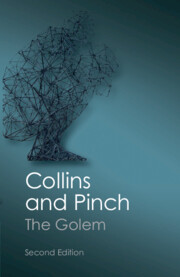Book contents
- Frontmatter
- Dedication
- Contents
- Preface to second edition
- Preface to first Canto edition
- Preface and acknowledgements
- Introduction: the golem
- 1 Edible knowledge: the chemical transfer of memory
- 2 Two experiments that ‘proved’ the theory of relativity
- 3 The sun in a test tube: the story of cold fusion 5
- 4 The germs of dissent: Louis Pasteur and the origins of life
- 5 A new window on the universe: the non-detection of gravitational radiation
- 6 The sex life of the whiptail lizard
- 7 Set the controls for the heart of the sun: the strange story of the missing solar neutrinos
- Conclusion: putting the golem to work
- Afterword: Golem and the scientists
- References and further reading
- Index
5 - A new window on the universe: the non-detection of gravitational radiation
Published online by Cambridge University Press: 05 February 2014
- Frontmatter
- Dedication
- Contents
- Preface to second edition
- Preface to first Canto edition
- Preface and acknowledgements
- Introduction: the golem
- 1 Edible knowledge: the chemical transfer of memory
- 2 Two experiments that ‘proved’ the theory of relativity
- 3 The sun in a test tube: the story of cold fusion 5
- 4 The germs of dissent: Louis Pasteur and the origins of life
- 5 A new window on the universe: the non-detection of gravitational radiation
- 6 The sex life of the whiptail lizard
- 7 Set the controls for the heart of the sun: the strange story of the missing solar neutrinos
- Conclusion: putting the golem to work
- Afterword: Golem and the scientists
- References and further reading
- Index
Summary
Detecting gravity waves
In 1969, Professor Joseph Weber, of the University of Maryland, claimed to have found evidence for the existence of large amounts of gravitational radiation coming from space. He used a new type of detector of his own design. The amount of radiation he saw was far greater than the theoretical predictions of astronomers and cosmologists. In the years that followed, scientists tried to test Weber's claims. No-one could confirm them. By 1975, few, if any, scientists believed that Weber's radiation existed in the quantities he said he had found. But, whatever it looks like now, theory and experiment alone did not settle the question of the existence of gravitational radiation.
Gravitational radiation can be thought of as the gravitational equivalent of electromagnetic radiation such as radio waves. Most scientists agree that Einstein's general theory of relativity predicts that moving massive bodies will produce gravity waves. The trouble is that they are so weak that it is very difficult to detect them. For example, no-one has so far suggested a way of generating detectable amounts of gravitational radiation on Earth. Nevertheless, it is now accepted that some sensible proportion of the vast amounts of energy generated in the violent events in the universe should be dissipated in the form of gravitational radiation, and it is this that may be detectable on Earth.
- Type
- Chapter
- Information
- The GolemWhat You Should Know About Science, pp. 91 - 108Publisher: Cambridge University PressPrint publication year: 2012



